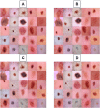Design and validation of a new machine-learning-based diagnostic tool for the differentiation of dermatoscopic skin cancer images
- PMID: 37058446
- PMCID: PMC10104315
- DOI: 10.1371/journal.pone.0284437
Design and validation of a new machine-learning-based diagnostic tool for the differentiation of dermatoscopic skin cancer images
Abstract
Background: Skin cancer is the most common cancer in the United States. Current estimates are that one in five Americans will develop skin cancer in their lifetime. A skin cancer diagnosis is challenging for dermatologists requiring a biopsy from the lesion and histopathological examinations. In this article, we used the HAM10000 dataset to develop a web application that classifies skin cancer lesions.
Method: This article presents a methodological approach that utilizes dermoscopy images from the HAM10000 dataset, a collection of 10015 dermatoscopic images collected over 20 years from two different sites, to improve the diagnosis of pigmented skin lesions. The study design involves image pre-processing, which includes labelling, resizing, and data augmentation techniques to increase the instances of the dataset. Transfer learning, a machine learning technique, was used to create a model architecture that includes EfficientNET-B1, a variant of the baseline model EfficientNET-B0, with a global average pooling 2D layer and a softmax layer with 7 nodes added on top. The results of the study offer a promising method for dermatologists to improve their diagnosis of pigmented skin lesions.
Results: The model performs best in detecting melanocytic nevi lesions with an F1 score of 0.93. The F1 score for Actinic Keratosis, Basal Cell Carcinoma, Benign Keratosis, Dermatofibroma, Melanoma, and Vascular lesions was consecutively 0.63, 0.72, 0.70, 0.54, 0.58, and 0.80.
Conclusions: We classified seven distinct skin lesions in the HAM10000 dataset with an EfficientNet model reaching an accuracy of 84.3%, which provides a promising outlook for further development of more accurate models.
Copyright: © 2023 Tajerian et al. This is an open access article distributed under the terms of the Creative Commons Attribution License, which permits unrestricted use, distribution, and reproduction in any medium, provided the original author and source are credited.
Conflict of interest statement
The authors have declared that no competing interests exist.
Figures








References
Publication types
MeSH terms
LinkOut - more resources
Full Text Sources
Medical

